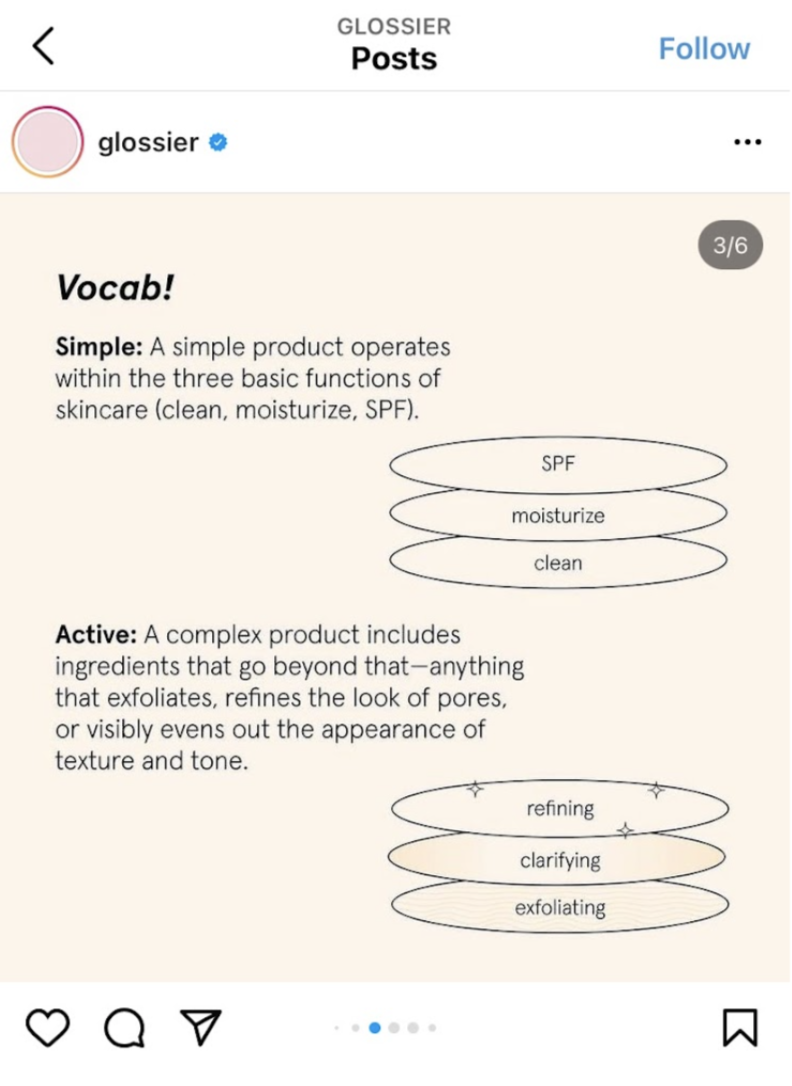Among Instagram’s lifestyle influencers, celebrity live streams, and branded content lies the app’s diametrically opposed social justice niche. Although these two corners of the app work to achieve divergent goals, accounts promoting social justice agendas and accounts working to generate revenue for a company often use the same means to reach different ends. Only one of the two are driven by profit, but they both exist within the constraints of a for-profit entity that values corporate content above all else.
A thorough browse through one of Instagram’s most popular social justice accounts, @so.informed, and a leading cosmetic brand with a prominent social media presence, Glossier, reveals two strategies that social activists employ to achieve success on social media.
@so.informed is home to close to 800 uniformly-designed posts. The account’s pastel-colored squares are decorated in a variety of minimalist-style fonts that spell out title slides, each presenting a unique social justice issue. A swipe across these title slides reveals a handful of graphics, familiarizing users with historical facts, terms and phrases, and action items related to said issue.
Topics include, but are certainly not limited to, “The Fight to Remove Confederate Statues;” “Advocating for Black Farmers;” “The Ethnic Cleansing of Palestine;” and “Masturbation, Pleasure, & the Orgasm Gap.” You can dabble in neuroscience by reading “Understanding Alzheimers” or free yourself from patriarchal brainwashing by reading “Mansplaining.”
In an effort to inform the public of these topics, @so.informed employs an aesthetic reminiscent to that of Glossier, a makeup and skincare brand that represents their company with similar simple, mute-toned posts. Critical of capitalism as they may be, the social-justice-oriented account uses visuals that parallel that of an explicitly for-profit company.

Jess Natale, creator of @so.informed, told Vox that she deliberately “settled on a more subdued palette of creamy pinks, yellows, and blues” in order to emulate brands that “speak to corporate-minded, girl-boss feminists.”
Like Glossier, @so.informed targets young women, and therefore capitalizes on the visual strategies that have been proven to grab the attention of this population. Glossier’s customers, described by Forbes as a “cult following,” respond well to the company’s visual marketing tactics. With only two brick and mortar locations, the brand – currently worth over $1 billion – depends heavily on its social media presence, making its aesthetic style a reliable precedent for @so.informed to follow.
In efforts to create and solve problems, advertisers often provide relevant tips, information, or self-help guides to their consumer bases that ultimately aim to push the company’s audience to seek out their products. Similarly, @so.informed’s feed is peppered with self-help related posts that are tangentially related to its goal of informing the public of social issues.
Take Glossier’s post, “Everything You Need to Know About Cleansing,” meant to provide its followers with a glossary of skincare-related terms that, while complementary, may ultimately drive people to purchase its skincare products. Similarly, @so.informed’s post, “Checking in With Yourself,” provides users with somewhat of a self-help service that encourages users to interact with their content.
An article on SocialMediaExplorer.com titled “The Ten Principles of Instagram Marketing” explains that, “Consumers like to follow brands, but only if they feel like they’re receiving mutual benefit. They don’t like to be annoyed by too many advertisements or promotional posts.” Although not tied to a brand, @so.informed adopts this strategy by sporadically interrupting its social justice related content to provide resources for its followers.
Of course, Glossier’s ultimate goal is to sell products, whereas @so.informed wishes to reel in an audience to consume their educational materials. The content of these two posts are vastly different, but they are formatted strikingly similarly and both serve the purpose of providing their followers with information that they hope will keep them engaged, and help build a relationship with their respective audiences built on mutual benefit.


_________
In a Vox article titled “How Social Justice Slideshows Took Over Instagram,” graphic designer and former Nike employee Eric Hu explains that, “Instagram privileges certain content, like attractive people, vacation photos, and graphics with inspirational messages. But now, you’re seeing a lot of infographics trying to Trojan horse these tropes to trick the algorithm.”
Activists have intentionally corporatized social-justice-related posts to appeal to the eye of the common consumer in order to cultivate a wide audience that may help realize their goals. It is safe to say that @so.informed’s strategy has been proven successful, as the account currently boasts almost four million followers.
Now worth $102 billion, Instagram’s value has increased over one hundred fold since Facebook Inc.’s acquisition of the company in 2012. It’s no secret that Mark Zuckerberg and his infamously wealthy counterparts profit from our usage of the photo-sharing app, but rarely do we take the time to make sense of the contradictions between our behavior on the app and the consequences of our engagement; Ironically, those who have a stake in Instagram’s success have seen their wealth skyrocket through investment in the very medium that has become a leading vehicle for the distribution of information related to social justice causes.
Nevertheless, accounts like @so.informed have not let Instagram’s for-profit priorities get in the way of their success. Rather than treating the app’s brand-favoring algorithm as an obstacle, @so.informed has co-opted the status-quo-maintaining nature of Instagram to promote a progressive agenda.
This piece was written as part of Professor Kelley Crawford’s, “Life Quest(ions)” series in her Alternative Journalism course at Tulane University.
 NOLAbeings
Multimedia artist Claire Bangser created NOLAbeings as a portrait-based story project that marries...
NOLAbeings
Multimedia artist Claire Bangser created NOLAbeings as a portrait-based story project that marries...
 Data corner: Adobe Suite (create a PDF, social media graphic, presentation, edit a photo and video
Data corner is where you go to work with analytics and top tech skills. It takes on everything from PERL and SQL to Canva and Sprout Social.
Data corner: Adobe Suite (create a PDF, social media graphic, presentation, edit a photo and video
Data corner is where you go to work with analytics and top tech skills. It takes on everything from PERL and SQL to Canva and Sprout Social.
